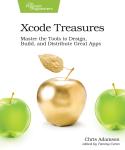About This Title
Pages: 241
Published: March 2019
ISBN: 9781680506273
In Print

Swift Style, Second Edition
An Opinionated Guide to an Opinionated Language
by Erica Sadun
Discover the dos and don’ts involved in crafting readable Swift code as you explore common Swift coding challenges and the best practices that address them. From spacing, bracing, and semicolons to proper API style, discover the whys behind each recommendation, and add to or establish your own house style guidelines. Refreshed to cover Swift 4 and 5, this practical, powerful, and opinionated guide offers the best practices you need to know to work successfully in this equally opinionated programming language.
eBook Formats:
PDF for desktop/tablets
epub for Apple Books, e-readers
mobi for Kindle readers
Get all eBook formats here for $21.95 (USD)
Paperback Formats:
Order via Bookshop (U.S. Only)
Please support indie bookstores!
Find indie bookstores in the U.S. Find indie bookstores around the world.
Apple’s Swift programming language has finally reached stability, and developers are demanding to know how to program the language properly. Swift Style guides you through the ins and outs of Swift programming best practices. Refreshed for Swift 4 and 5, this is the best practices book for serious, professional Swift programmers and for programmers who want to shine their skills to be hired in this demanding market.
A style guide offers a consistent experience of well-crafted code that lets you focus on the code’s underlying meaning, intent, and implementation. This book doesn’t offer canonical answers on Swift coding style. It explores the areas of Swift where structure comes into play. Whether you’re developing a personal style or a house style, there are always ways to enhance your code choices. You’ll find here the ideas and principles to establish or enhance your own best style practices.
Begin with simple syntactical styling. Perfect spacing and layout. Master literal initialization and typing. Strengthen code bracing for easy readability. Style your closures for safety and resilience. Optimize control flow layout and improve conditional style choices. Transition from Objective-C and move code into Swift the right way. Boost API design using proper naming and labeling. Elevate defaulted arguments and variadics to their right places. Finally, Erica offers her own broad recommendations on good coding practice.
What You Need
A recent version of the Swift programming language.Resources
Releases:
- P1.0 2019/03/26
- B5.0 2019/02/26
- B4.0 2019/01/29
- B3.0 2018/12/12
Contents & Extracts
- Welcome to Swift
Style

- How This Book Got Here
- What’s in This Book
- Contributing to This Book
- Online Resources
- Language Evolution
- Ready to Get Going?
- Credits
- Thanks
- Adopt Conventional Styling
- Reaching for Consistency
- Understanding Inattentional Blindness
- Adopting Conventional Spacing
- Mandating Maximum Line Widths
- Selecting Colon
Styles

- Placing Attributes
- Moving Variables and Constants to the Left
- Formatting String Literals
- Formatting Number Literals
- Balancing Inferred and Explicit Typing
- Constructing Collections with Literals
- Optional Sugar
- Mitigating Optional Constipation
- Converting to Tuples
- Considering Comma-First Styles
- Wrapping Up
- Structure Your Code for Readability
- Taking Control of Swift Structure
- Understanding Swift Semicolons
- Structuring Single-Line Clauses
- Hugging Parentheses
- Wrapping Argument Lists
- Pushing Declaration Argument Parentheses Leftward
- Coaligning Assignments
- Improving Closure
Hygiene

- Choosing Trailing Closures
- Laying Out Partial Application
- Laying Out Complex Guard Statements
- Laying Out Ternaries
- Binary Conditionals
- Laying Out Long Collections
- Weighing Late Property Declaration
- Wrapping Up
- Establish Preferred Practices
- Testing Assumptions
- Choosing Optionals
- Casting Conditionally
- Chaining Calls
- Moving from Thrown Errors to Optionals
- Unwrapping Variables
- Distinguishing flatMap from compactMap
- Mapping in Condition Clauses
- Iterating Collections of Optionals
- Working with Optional Collections
- Adding Lazy Evaluation
- Selecting Sequences and Strides for Numeric Progressions
- Looping
- Indexing and Enumerating Collections
- Switch Statements
- Declaring Number Constants and Variables
- Implementing Getters and Setters
- Returning Void
- Grouping Initializers
- Using Call Site Type Inference
- Evaluating Case-Binding
Syntax

- Using if/guard-case
- Choosing Capture Modifiers
- Toggling Boolean Values in Place
- Testing Sequences for Boolean Logic
- Double-Testing Boolean Logic
- Boolean Optionals
- Using Division Logic
- Other Practices
- Wrapping Up
- Design the Right APIs
- Adopting Access Control
- Avoiding Global Symbols
- Nesting Functions
- Nesting Types
- Designing Singletons
- Adding Custom Operators
- Naming Generic Parameters
- Naming Symbols
- Plurality
- Choosing Label Names
- Initializers
- Convenience Initializers
- Factory Methods
- Naming Methods and Functions
- Tips for Naming
- Mutating Variations
- Computed Properties vs. Methods
- Adding Defaults
- Protocols
- Generic Beautification
- Adding Typealiases
- Choosing Value vs. Reference Types
- Writing Good Errors
- Wrapping Up
- Look to the Past and the Future
- Reconciling Past You vs. Future You
- Documenting in Real Time
- Adding Structured Markup
- Commenting Well
- Organizing with Bookmarks
- Removing Boilerplate Code
- Addressing Consistent Fatal Outcome
- Improving Code Descriptions
- Avoiding Clever
- Wrapping Up
- Good Code
Author
Erica Sadun enjoys deep diving into technology and has written, co-written, and contributed to dozens of books about computing and digital media. Erica has blogged at TUAW, Ars Technica, O’Reilly, and Lifehacker, and has (to date) authored or co-authored more Swift proposals than anyone, including everyone on Apple’s Core Team.eBook Formats:
PDF for desktop/tablets
epub for Apple Books, e-readers
mobi for Kindle readers
Get all eBook formats here for $21.95 (USD)
Paperback Formats:
Order via Bookshop (U.S. Only)
Please support indie bookstores!
Find indie bookstores in the U.S. Find indie bookstores around the world.
Related Titles:

About This Title
Pages: 241
Published: March 2019
ISBN: 9781680506273
Edition: 1
In Print




